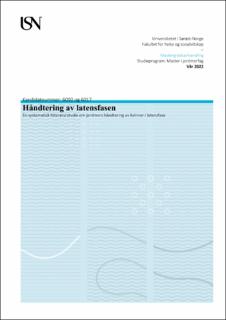Håndtering av latensfasen
Master thesis
Permanent lenke
https://hdl.handle.net/11250/3000376Utgivelsesdato
2022Metadata
Vis full innførselSamlinger
- Master i jordmorfag [42]
Sammendrag
Hensikt: Hensikten med denne oppgaven er å belyse kunnskap om jordmors håndtering av fødselens latensfase.
Problemstilling: Hvordan er jordmors håndtering av fødselens latensfase beskrevet i forskningslitteratur?
Metode: Kvalitativ litteraturstudie. Systematiske søk i aktuelle databaser ble gjort for å finne kvalitative studier som omhandler jordmors håndtering av fødselens latensfase. Disse ble deretter syntetisert ved hjelp av tematisk analyse.
Resultat: Når en kvinne kontakter fødeavdelingen, forsøker jordmor å danne seg et helhetsbilde av situasjonen til kvinnen. Dette gjør hun gjennom å kartlegge kvinnens historie og mestringsnivå og det gjøres en vurdering av hvor i fødselsforløpet kvinnen befinner seg. Jordmødres håndtering av fødselens latensfase er også preget av forhandling og balansering. På den ene siden utgår de fra en samhandling med kvinnen, men de er også påvirket av avdelingens kultur og institusjonens retningslinjer. Det kom frem at jordmødre balanserer kvinners behov for trygghet opp mot fulle fødeavdelinger og mangel på personale. Dessuten fungerer jordmødre som «portvoktere» i avdelingen, hvorpå de ønsker å beskytte kvinnene fra intervensjoner dersom de legges inn på fødeavdelingen for tidlig.
Konklusjon: Slik helsesystemet er lagt opp i dag, handler håndteringen av kvinner i latensfasen om å gjøre en helhetsvurdering. Samt å balansere kvinners behov for trygghet opp mot fulle fødeavdelinger, mangel på personale og et ønske om å beskytte kvinner fra obstetriske intervensjoner dersom de blir innlagt på fødeavdeling i latensfasen. Aim: The purpose of this study is to shed light on the research concerning midwives’ management of the latent phase of birth.
Issue: How is the midwife’s management of the latent phase of birth described in research literature?
Method: Qualitive literature study. Systematic searches in relevant databases were made to find qualitive studies that deal with midwives’ management of the latent phase of childbirth. These were synthesized using thematic analysis.
Result: When a woman arrives at the maternity ward, the midwife seeks to form a complete picture of her situation. She does this by taking the woman’s history, assessing her coping strategies and determining where in the birth process she currently is. How the midwives handle the latent phase is also characterized by negotiation and balancing the needs of the women with the needs of the staff. On one hand their strategy is based on the interaction with the woman, but they are also influenced by the maternity ward’s culture and the guidelines of the hospital. The midwives took into account the women’s need of security balanced against the busy maternity ward and lack of staff. In addition, midwives act as ‘gatekeepers’, seeking to protect the women from unnecessary interventions if admitted too early into the ward.
Conclusion: The way the health system is currently working, the care for women in the latent phase of birth is concerned with making an assessment of the overall situation. Also, balancing the women’s need for reassurance in busy and understaffed maternity wards, and a wish to protect women from obstetric interventions if admitted to the labor ward during the latent phase.
